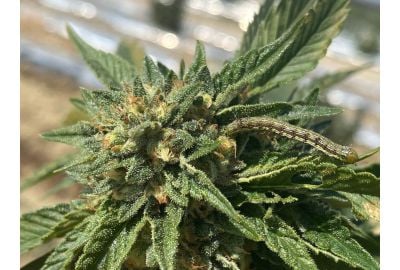Cannabis Caterpillars: Signs & Solutions
What’s that on my freshly frosted buds? Why is it moving? Eek! Cannabis caterpillars.
That’s at least how we imagine a grower’s thought process upon encountering wormlike shapes on their weed crops. You expect flies and aphids, but these nasties come as a surprise.
Or you might notice chunks of leaves gone missing or clumps of excrement over the foliage. These are less nauseating but equally disconcerting ways to discover marijuana caterpillars.
What now? Can you save your harvest?
Join us for a complete breakdown of caterpillars on cannabis. We’ll talk about the biology behind these creatures, the damage they can do, and ways to prevent and cure the issue.
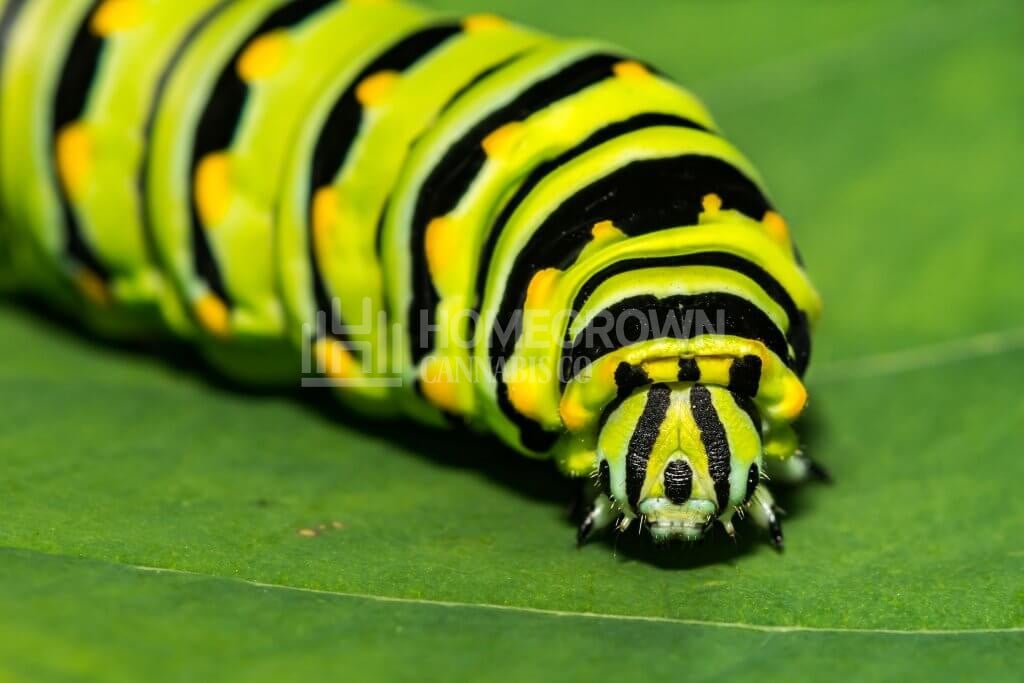
What are cannabis caterpillars?
If you’re not an outdoorsy person, this might be your first time facing weed caterpillars in person. Let’s start with a brief biology rundown to help you comprehend what you’re seeing.
Note: Facing a time-sensitive marijuana caterpillar crisis? Skip ahead to the section on cures. Come back when you have time to read.
Caterpillars are the larval stage of all moths and butterflies. There are over 175 thousand species globally, and most are herbivorous.
They’re soft-bodied and anywhere between 1 millimeter and 14 centimeters in length. They have detailed anatomy, which can help you differentiate them from other nuisances.
Notable features include:
- A segmented body of three parts
- A maximum of five pairs of legs
- Twelve simple eyes
- Crochets on the legs
- Y or V-shaped lines on the head
The colors and shapes vary between species. Not all insects from this category love marijuana plants, but we’re not discussing cannabis caterpillars for nothing. Some American species, including the Hemp Borer and Corn Borer, are super-destructive for weed.
The life cycle of cannabis caterpillars
You learn quite a lot about natural life while learning how to grow cannabis outdoors!
You might shudder at the thought of bugs and insects, but knowledge goes a long way. Understanding various pests is the cornerstone of combating infestations with smart practices, not brute force.
The situation is tricky with weed caterpillars—after all, these turn into butterflies! There’s a thin line between killing plant-eaters and ridding your garden of beneficial biodiversity.
When should you kill caterpillars in cannabis, and when can you leave them to develop? It’s a question of understanding their life cycle.
Their biorhythm is straightforward, happening across several stages:
- Butterflies lay eggs, which eventually hatch.
- Caterpillars emerge and immediately start feeding on nearby plants.
- They keep eating and growing until they reach a certain size (it’s species-specific).
- They enter the pupal phase, which often includes cocoons. That’s when metamorphosis takes place.
- After a week to a month, new butterflies or moths appear.
So, if you see active marijuana caterpillars, you should kill them. They’re ravenous as they inch towards the pupal stage, and they can do a lot of damage along the way. What if you fail to notice a colony on the crops? Your weed plant will show clear signs of distress, so watch out.
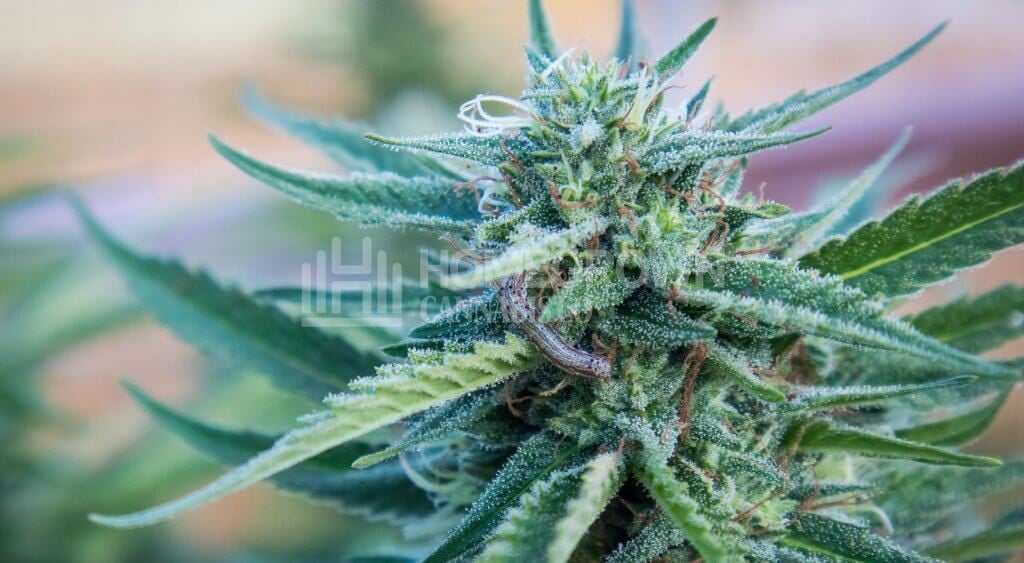
Signs of caterpillars infestation on cannabis plants
Caterpillars on weed plants aren’t discreet. The infestation can cause a few foliage holes if the insects are few and unmotivated. Worst case scenario is extreme, leading to total devastation of the specimen and yield loss.
No matter the severity, marijuana caterpillars leave telltale damage in their wake, including:
- Irregular holes on the foliage. These hungry beasts aren’t neat or systemic. They munch on the leaves where they can, leaving odd holes behind them.
- Stem weakness and damage. Many borer species bypass the leaves and feast on the dense insides of cannabis branches and stems. The stalk weakens and starts tilting.
- Foliage yellowing. Damaged leaves and stems aren’t effective in transporting water and nutrients. The leaves above the damage point get discolored, signaling trouble.
- Chewed and wilted flowers. Marijuana caterpillars feast on budding colas, and they’re big fans of resin. They aim for new bud bases, which results in eventual cola death.
- Stunted crop, leaf, and bud growth. This side-effect isn’t a direct product of weed caterpillars, but their constant munching stresses the plants. As a result, they reduce size and productivity.
Are you looking at this list and your garden, desperately thinking: oh no, there are caterpillars on my weed plants? Let’s discuss what damage type and severity you might expect.
What kind of damage do cannabis caterpillars do?
Cannabis pests often look small and unassuming, but they’re bad news. Weed caterpillars are no exception.
These insects are super-ambitious as crop eaters. Their activity removes vital parts of your cannabis plant and messes with its structural integrity. You end up with a crop that can’t reach its full potential, or worse, ruined, unsmokable flowers.
They often start on the inner core of the stalk, weakening the stem until it breaks down. They also munch on the larger foliage and bud sites, rendering these sections of your crop unproductive and unusable.
Caterpillar weed isn’t healthy weed, but the extent of harm varies. A minor infestation leaves holes scattered across the fan leaves. A larger-scale problem can lead to fatal damage.
The species also play a role. There are thousands of potential caterpillars on cannabis in America. Some are small and unproblematic, while others spell bad news from the get-go.
You can’t easily determine the cannabis caterpillar numbers and species, though. It’s better to remove them from your growing space than to play the game of chance.
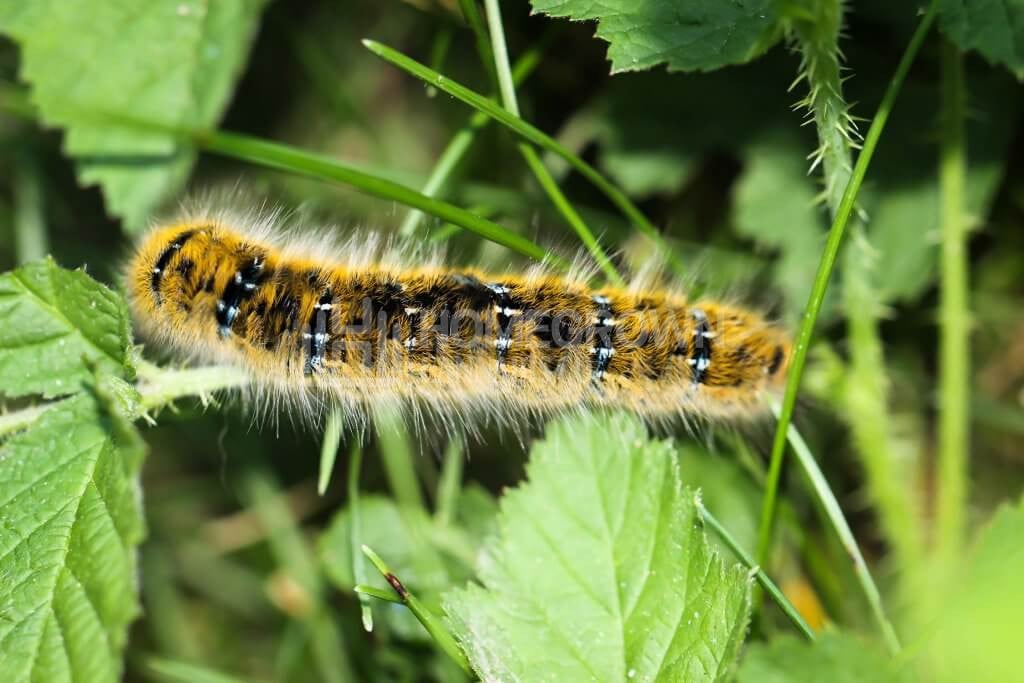
How to get rid of caterpillars on weed plants?
If you found this guide upon noticing crawly creatures, your question is singular and straightforward. How to get rid of caterpillars on weed plants?
We come bearing good news. Although they can do real damage, it’s pretty simple to deal with cannabis caterpillars. And no, we’re not suggesting that you use pesticides.
Spraying your crops and living soil brings more harm than good.
We’re discussing natural and organic means of removing marijuana caterpillars. You have several viable options:
- Physically remove the specimens from your crops. Unlike aphids and other camouflage pests, cannabis caterpillars are easy to spot. Pick them up and relocate them somewhere where they won’t cause issues.
- Employ predator species. If the infestation is larger, a hunt won’t work in your favor. Instead, put an army of beneficial insects to work. Parasitic wasps and praying mantises will love you for the feast.
- Use an organic bacterial spray with Bacillus thuringiensis. These natural pesticides kill weed caterpillars without damaging the plant or the smoker. Finish spraying several weeks before harvest time.
- Employ homemade insecticide. Feeling iffy about chemical sprays, even if they’re organic and non-harmful? You can treat smaller-scale problems with a blend of garlic and pepper. Expect spicier buds than usual!
Now, flowering stage cannabis issues are a major anxiety source for cultivators. These solutions work across the board, but let’s spend a moment discussing caterpillars on weed plants’ buds.
How do I get rid of caterpillars on my buds?
There’s no sadder sight than an intruder on your sticky buds. What should you do?
Well, the first step is physical removal. It’s usually better to cut off the branches with infested flowers. Eaten colas would die out anyway, and disposal keeps the rest of your plant safe.
You could also spray the buds with the same insecticide you’d use on the stems. Flush the crop several times before collecting the buds and always use a safe product.
If you had weed caterpillar issues but managed to reach the harvest stage, hang the plant upside down after cutting it from its stem. Remove any critters you notice. The rest are likely to leave as the crops release moisture.
What if you don’t get them all? Caterpillars on drying buds aren’t a pretty sight, but your harvest is still salvageable. Check the buds for damage and get rid of those that had caterpillars on them. Dunk the rest in water before drying them to remove any lingering nasties. The remaining bacteria will perish upon combustion, leaving you with a safe toke.
How to prevent caterpillars on weed plants?
You might be reading this to get informed and cringing internally. The cures we discussed aren’t challenging, but you don’t want to have to do them. Your main question will be how to keep caterpillars off weed plants in the first place.
To start, master the basics of how to protect an outdoor grow. Employing these basic practices decreases the risk of cannabis caterpillars.
It doesn’t hurt to take additional measures to prevent these critters, either, especially if you think your garden might be a hotspot. Good practices include:
- Introducing beneficial biodiversity in your garden. Populate your patch with patrolling insects before sowing weed seeds. Caterpillars have many natural predators, like parasitic wasps and flies, lacewings, assassin bugs, and ground beetles.
- Employing barrier fabrics around the crops. DIY a barrier with a wooden frame and a layer of translucent fabric around the crop. If butterflies and crawlers can’t reach the plants, they won’t feast and lay eggs. As a bonus, this one works as overall protection.
- Treating the soil with neem oil. This South Asian essential oil acts as a natural pesticide. Drench the earth with a derivate to deter harmful insects. Use it as a foliar spray to double the safeguard.
Besides these steps, take extra care of your garden. Stay attentive around your plants and check them daily. If you notice butterflies gathering around your crop—or worse, sitting on them—act immediately. They could lay eggs and launch a weed caterpillar infestation.
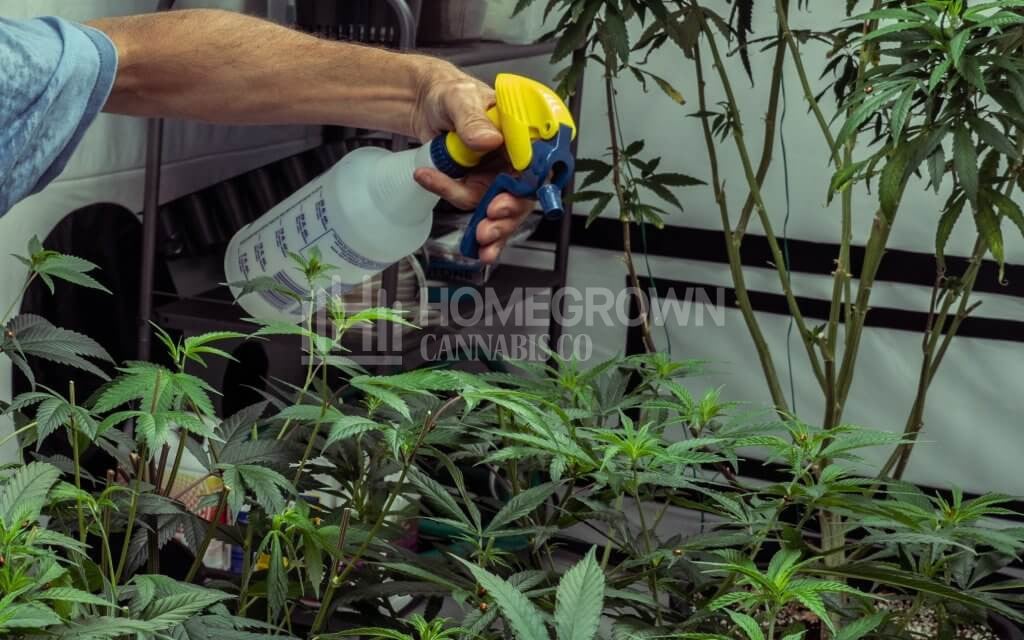
Caterpillars on cannabis: Nasty but not world-ending
In the end, you’re best off preventing a cannabis caterpillar infestation. It might feel bad to kill off garden biodiversity, but it’s a matter of priorities. If we had to choose, we’d take healthy buds over healthy crawlers any day of the week.
The preventative measures we discussed work like a charm. If you’re dealing with an infestation as we speak, the list of cures is equally effective.
Don’t forget all about these critters once you’ve saved your harvest. Apply the protections before the next growing season to nip the problem in the bud.
Now that you understand weed caterpillars, why not put your knowledge to the test? Get the highest-quality outdoor seeds at Homegrown and practice your natural cultivation skills.
Stay tuned to our blog for guides on all things cannabis. Our educational resources are here for every aspiring grower, supporting prolific gardens across the globe.
About the author: Parker Curtis
Parker Curtis has around a decade of cannabis-growing experience, specialising in soil-less and hydro grows. He’s mastering outdoor, greenhouse, and indoor grows.
